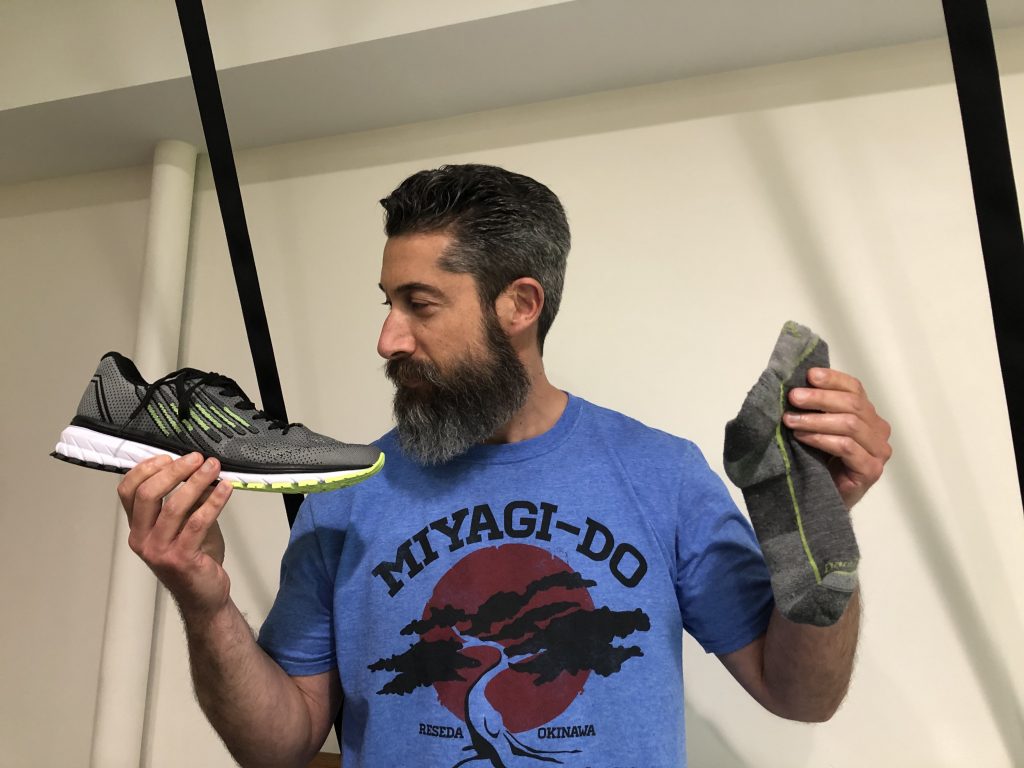My feet are important to me, and they are involved in every activity that I do: training clients, lifting weights, going for walks, hiking, playing basketball and doing yard work. Sometimes it can be difficult to know why my feet or legs or back are sore after a particular activity. Is it the shoe? Is it overuse? Or both? Some people say that it’s age catching up to me. That’s not very nice :-)
A close friend and I have talked about shoes, shoe inserts, socks, and general footwear for many years. We’ve had long discussions on the subject. Given that my friend, Dave, who works as a postal carrier, walks 10+ miles a day and is an avid runner, I feel that he is an expert on the matter. What conclusions did we come up with? What are some solutions? First of all, we need to understand that shoes get compressed over time just by standing in them. I’ve had 6-month old shoes that outwardly look new with no visible signs of wear, but they feel like bedroom slippers when I put them on. And that’s not a good thing if you need a supportive shoe for certain exercises. Another thing Dave and I agreed on is that I am a sensitive person. Like Hans Christian Andersen’s “The Princess and the Pea”, I fortunately or unfortunately notice small changes in the performance of my socks and shoes. These changes can result in foot and calf soreness. If I continue wearing those same shoes and socks, sometimes the discomfort will move up to my hip, back or even neck.
I’ve been told by long distance runners and have even read on shoe manufacturer’s websites that running shoes have a preset mileage built into them. Usually 400 to 500 miles. Is that just marketing so you buy next years’ model? Hmm. Whether it’s 400, 500 or 1000 miles, eventually the synthetic leather, plastic, knit polyester, foam and rubber will degrade with each footfall. Be watchful. Depending on how you walk or run, your shoes may wear unevenly. And that “unevenness” and imbalance may further contribute to foot, ankle, knee, hip or back soreness or injury.
Eric, are you saying that I need to buy a new pair of shoes every 4 or 6 months? That depends on what activities you’re doing, your budget and how your body is feeling. I have a client who has worn the same athletic shoes for 13+ years and feels that they are supportive. He says that he only wears them to train with me, but I’m sure they are waaaaaay overdo.
The same is true with socks. Socks can help wick away moisture (which reduces rubbing and blisters), add support to your foot and ankle, provide cushion under your heel and the ball of your foot and help regulate temperature. All this with a sock? Yes. As a matter of fact, I have almost entirely replaced all of my socks with Darn Tough Hiker 1/4 socks. I’m wearing them right now, and I can’t say enough about them.
What are some ideas to add longevity to your shoes and socks?
- Alternate shoes. We often put new socks on every day, but we put on the same shoe. That shoe may still retain moisture from the previous day and is still recovering. So wear another pair.
- Wear the right shoe for the job. DO NOT and I repeat DO NOT wear old athletic shoes for yard work or going for walks or taking the dog out or anything. Remember different activities require different footwear. I remember training a client who was complaining about ankle pain after participating in some outdoor bootcamp classes (with another fitness trainer) at a nearby park. Looking at her running shoes, I asked if she was wearing those same shoes at the park in the morning on the dewy grass. She said Yes. The soles of her shoes were worn down so she would have no grip on the grass. I added that doing any side-to-side movements in running shoes wasn’t a good idea either since running shoes provide no lateral support.
- Don’t let your feet get cold. Have you noticed how your car performs differently in the winter? It takes longer to warm up and the tires may feel harder on the road. That’s because of the cold. If your feet get cold and you go for a run, for example, your footfalls, propulsion, ankle extension, etc will be abbreviated. That may lead to poor technique, reduced performance and/or injury.
- Stretch your legs and feet. We are usually pretty good about stretching quads, hamstrings and calves, but don’t forget to stretch your ankles and feet.
- Take a break and get off of your feet. If possible, give your feet a rest. I have joked over the years that since I stand and exercise for a living that I can sit for a loooong time. . . and watch TV. . . and nosh. When you are in a standing position, blood flows down to your feet. If blood pools in your feet, they may swell making your shoes and socks feel tighter and uncomfortable. Muscle contraction in your feet and legs send the blood back up. Blood pooling can even happen when we are sitting. So sometimes it’s a good idea to kick off your shoes and put your legs up when you get home.

